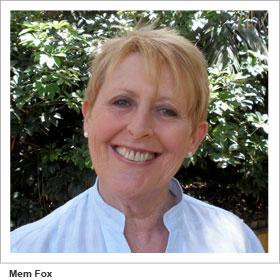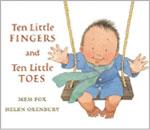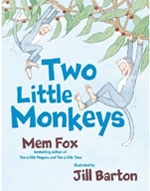Bond through Reading: An Interview with Mem Fox

You are here
 Mem Fox is picture book author of many beloved books for children, including Ten Little Fingers and Ten Little Toes. Assistant Editor Meghan Dombrink-Green interviewed Mem about children’s books and why reading aloud to children is so important.
Mem Fox is picture book author of many beloved books for children, including Ten Little Fingers and Ten Little Toes. Assistant Editor Meghan Dombrink-Green interviewed Mem about children’s books and why reading aloud to children is so important.
Can you talk about the bonds between parents and children that come from reading aloud?
Parents get to know their children through the way they read to their children and what they’re reading. Parents get to know their children’s character, and children get to know their parents. There’s a fondness that develops that’s just gorgeous.
When they’re reading to their children, how can parents expand on the book or text or the words in a book?
The book will initiate conversations that go for miles, on this detour and that. They talk about the world and the way it works, relatives who live close by or don’t, things that happen during the day. The book is a pathway to the rest of the world, to a huge conversation about what’s going on in the child’s life.
Your book Ten Little Fingers and Ten Little Toes contains a lot of repetition. How does repetition works in read-alouds and how does it help children learn to read?
 Rhyme, rhythm, and repetition are incredibly important in books for small children. When children are born, they’ve been used to the mother’s heartbeat in the womb. When they’re born, they’re rocked and cradled. There is a rhythm to life itself. There’s rhythm in the nursery rhymes and songs that are sung to children. And those rhythms and rhymes are like a bridge from spoken language to the written language.
Rhyme, rhythm, and repetition are incredibly important in books for small children. When children are born, they’ve been used to the mother’s heartbeat in the womb. When they’re born, they’re rocked and cradled. There is a rhythm to life itself. There’s rhythm in the nursery rhymes and songs that are sung to children. And those rhythms and rhymes are like a bridge from spoken language to the written language.
As an educator, I know that if children cannot learn the skill of predicting what’s going to come next in language, they can’t learn to read. They have to know what’s coming next in a sentence. Otherwise they might read a sentence as, “He galloped away on his house.” He or she might not know that doesn’t make sense. But a child who can read “galloped” will know that it’s going to be horse next and not house. The child can predict what it’s going to be and then check it with the print. The ability to predict language is crucial to learning to read and picture books teach that prediction.
How can parents of infants, toddlers, and preschoolers encourage a love of reading?
Read from birth and keep doing it. Start from birth with the right book and know your child. Know what they can stand, know whether they need a very short book or not. You have to know your child, and you have to know your books.
Finding the right book is about asking friends, asking librarians, and asking childcare teachers. It’s about looking online at blogs by people who love children’s books, read them to their children, and blog about it. I think people will be surprised by what their children like and don’t like. Our grandson loves a particular book about a witch and a cat, but neither my husband nor I can bear reading it to him. You can never account for what they want, but you have to go with their taste. So we read that darn book over and over again!
I’m also very, very surprised at what my grandson can cope with in terms of length. My book The Goblin and the Empty Chair is not appropriate for his age group. He doesn’t understand what it means. He can’t possibly know what a goblin is. He can’t know what a “still pond” is, and yet he is absolutely mesmerized by that book. I would’ve said that that was a book for 5- to 7-year-olds. So, just because a book is long doesn’t mean to say that the child won’t like it. Conversely, just because a book is short doesn’t mean a child will like it.
Can you tell us about your two new books, Two Little Monkeys, which came out in May, and Tell Me About Your Day, published in September, about a boy who talks to his stuffed animals about his day?
 I’m thrilled about Two Little Monkeys for two reasons: (1) I grew up in Africa and it’s a very African book, and (2) it’s the kind of book that I know children will learn to read by because of its repetition and rhythm and simplicity.
I’m thrilled about Two Little Monkeys for two reasons: (1) I grew up in Africa and it’s a very African book, and (2) it’s the kind of book that I know children will learn to read by because of its repetition and rhythm and simplicity.
You know when you ask children “What happened today?” they often say nothing happened. In Tell Me about Your Day Today, I wanted to nudge children into remembering that when they are dropping off to sleep they can look back on the day and think about all the things that happened.
I know that lots of children have a special toy, and I love the idea of a child telling the toys—and the toys telling the child—about their day, after the lights are out and when the child is alone in bed.